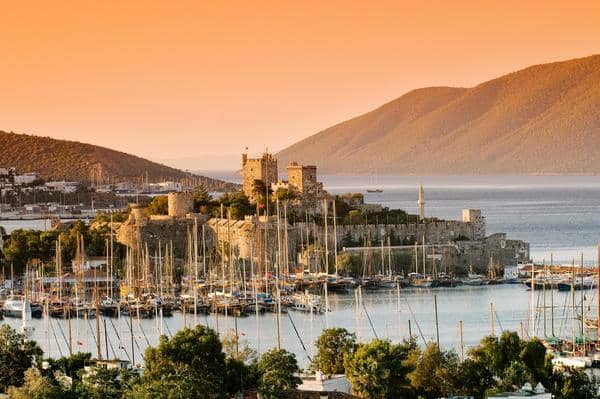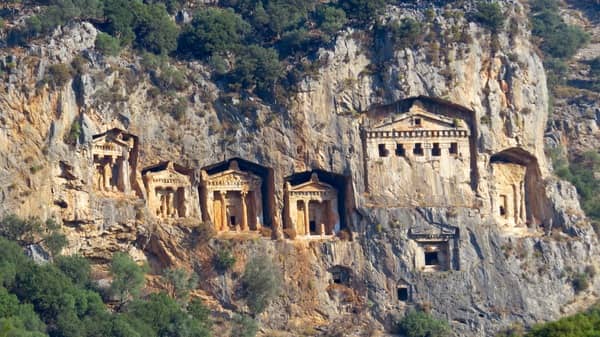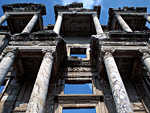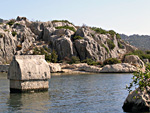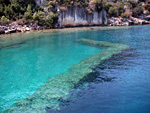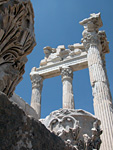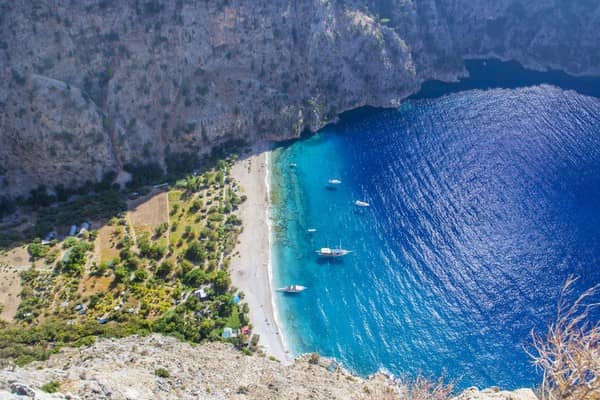Sailing holidays Turkey
Turkish coasts
Sailing in Turkey means cruising along the many gulfs and bays of the much indented Turkish coastline. It is also a journey back in time, with a plethora of archaeological sites, castles and temples that reflect its importance in ancient and medieval times.
Especially the south-west coast – roughly speaking the stretch of coastline from İzmir via Kuşadası, Bodrum, Marmaris, Fethiye and Kaş to Antalya – is the ideal cruising ground.
This marvellous stretch of Turkish coastline is traditionally divided, with some overlap, into four different yacht charter areas:
Secular and religious
Islam means “submission” or “one that submits himself” in Arabic, whereas Moslim means the same but is a Persian word.Despite the myriad minarets these coasts are surprisingly secular: LGBT-friendly; the Turkish baths are often mixed; alcohol is consumed.
- The Ionian Coast: a coastline which claims to have the best climate and which shores brought forth the rich culture of the Ionians and their great philosophers; İzmir – Çeşme – Sığacık – Didyma – Kuşadası – Güllük
- The Carian • Dorian Coasts: the most popular sailing grounds in Turkey which includes several major yacht charter bases; Yalıkavak – Turgutreis – Ağaçlı Koyu – Bodrum – Knidos – Datça – Marmaris
- The west Lycian Coast: the pirate coast with its wild, mountainous shores and hundreds of hidden coves; Marmaris – Göcek – Ekinçik – Dalyan (Kaunos) – Fethiye
- The east Lycian Coast: small islands, villages, rock tombs and solid stone sarcophagi; Fethiye – Kaş – Ölüdeniz (Kekova Roads) – Kalkan – Finike – Antalya
Flights and airports
There are several flights each day from Istanbul, Antalya, Ankara to Milas-Bodrum airport, which is 40 minutes from Bodrum harbour.
Full list of airlines and (domestic) destinations Milas-Bodrum airport. Alternatively, fly on Kos airport and take the short ferry trip to Bodrum port.
Likewise, there are frequent flights from Ankara, Istanbul, etc. to Dalaman airport, which is 30 minutes from Göcek, 60+ minutes from Fethiye and 90 minutes from Marmaris.
Full list of airlines and (domestic) destinations Dalaman airport. Alternatively, fly on Rhodes airport and take the ferry to Marmaris port.
For the east Lycian coast use Antalya airport; full list of airlines and (domestic) destinations Antalya airport.
If you wish to charter a yacht and would like independent advice on reliable charter companies in Turkey, please see my yacht charter or gulet charter pages.
Turkey abounds with archaeological ruins dating from the dawn of civilization, inhabited by various Anatolian tribes, conquered, and occupied by Persians, Egyptians, Greeks, Romans, Byzantines, Arabs, Ottoman Turks, and finally establishing independence in the 1920s under Ataturk.
Besides the rock tombs and sarcophagi, most relics are of Greek and Roman origin. Many of the ruins are just part of the landscape, not fenced off.
Religion in Turkey
The minarets, covered bazaars, the exotics smells and of course the fairy tale palaces of the sultans, all instill the feeling of travelling the orient in a country that is not only foreign but also harbours a predominantly moslim population.
Yet, it is very important to realize that the Turkish state is not Islamic, but rather secular and enlightened, with much more separation between state and religion than in for instance the USA. Even under the reign of Erdoğan (whose politics ravaged the tourist and yacht charters industry since 2015) Turkey is still officially a secular state.
It was the father of all Turks – Mustafa Kemal Atatürk – who diminished the influence of the islam, introduced laicism and transformed Turkey into a modern and western orientated country, even embracing the Latin script (with some additional diacritical marks, see below).
Although 90% of the population is Moslim, most take a very pragmatic role toward their religion and are not regular visitors to mosques and don't pray as often as is dictated.
Moreover, in the cruising areas religiosity is far less than in the north and north-east provinces of Turkey. The locals are gay-friendly and the kindly disposed towards women!
Crewed yacht charters or Gulets
Besides marvellous options for bare-boating, many sailors will appreciate the luxury Gulet cruises or Blue Voyages. Although these sailing holidays lack the privacy of a bare boat, you will be pampered and catered to your every whim by your own captain, chef cook and hostess: the zenithal luxury crewed charters!
Blue cruises
These gulet holidays known as Blue Voyages or Blue cruises originate from the time that Cevat Sakir Kabaagacli – a political writer – was exiled, rather erroneously, to Bodrum.
The judges who sentenced Cevat Sakir to a number of years in the remote port, knew nothing of local life, which as Sakir discovered, was heaven on earth. He settled down and started writing stories about the town and its locals, in particular, the fishermen.
On his regular outings with these fishermen, he gradually got to know the various coves and bays near Bodrum and introduced this rich fisherman's life to visiting writers, scholars and artists from Istanbul. Sakir's tours became famous and were given the name “Blue Cruises”…
For independent advice on Gulet companies (private charters only) please see my gulet charter page.
Turkish Language
Ottoman Turkish was originally written in Arabic script, but was converted to Roman letters in 1928.
The modern Turkish alphabet contains 29 letters. There are 8 vowels and 21 consonants, and the letters Q, W, X do not appear, yet there are 6 unusual pairs of minuscules and capitals
| Name | Character | Name | Character |
|---|---|---|---|
| Dotted I | İ | Breve G | Ğ |
| Dotless i | ı | Breve g | ğ |
| Diaeresis O | Ö | Cedilla C | Ç |
| Diaeresis o | ö | Cedilla c | ç |
| Diaeresis U | Ü | Cedilla S | Ş |
| Diaeresis u | ü | Cedilla s | ş |
There are four back vowels (a, ı, o, u) and four front vowels (e, i, ö, ü). If the vowel of the first syllable of a word is a back vowel, succeeding vowels will normally also be back vowels; similarly front vowels follow front vowels.
Exceptions to this rule are mainly in words of foreign origin and then, in general, suffixes follow the vowel in the last syllable. This is known as the rule of vowel harmony.
Suffixes are used when words are declined to indicate their case, and to give additional meaning. These normally follow the rule of vowel harmony. A few nautical examples:
| Declination | Suffixes | Nautical examples |
|---|---|---|
| Posessive | -ı, -i, -u, -ü | Gökova Körfezi = Gökova Bay, from körfez = bay |
| Posessive | -sı, -si, -su, -sü | Marmar Adası = Island of Marmara, from ada = island |
| Plural | -lar, -ler | Adalar = Islands |
| Adjective | -lık, -lik | Kayalık = Rocky, from kaya = rock |
Pronunciation
Generally stress is laid equally on all syllables of a word.
Letters are pronounced as in English with the following exceptions:
| Letter | IPA | Sounds as |
|---|---|---|
| c | [ dʒ ] | “j” in “jealous” |
| ç | [ tʃ ] | “ch” in “chop” |
| ğ | [ j ] | between two front vowels, as “y” in “yet” |
| ğ | [ ː ] | between two back vowels, not sounded, but the preceding vowel is lengthened |
| ı | [ ɯ ] | something between “i” in “big” and “u” in “bug” |
| j | [ ʒə ] | “su” in “pleasure” |
| ö | [ ɜ ] | “u” in “urn” or “ea” in “earth” |
| ş | [ ʃ ] | “sh” in “shop” |
| ü | [ u ] | “e” in “yew” or in the French "tu" |
| er | [ eər ] | “air” in “fair” |
| ey | [ eı ] | “ai” in “pain” |
| ay | [ aı ] | “i” in “mine” |
A handy list of Turkish phrases for your sailing holidays or blue cruises in the Turquoise waters of Turkey.
A selection of Turkish terms found on charts and in nautical publications.
Best ports in Turkey
The Hisarönü Gulf south of Bodrum – around the Knidos cape that is – is home to quite a few very spectacular harbours, but also quite a few ports to the north are exceptional:Important reading
Blue cruises on gulets & motorsailers
The best gulet charter companies
Selecting your (bareboat) charter yacht
Catamarans vs monohulls
8 steps towards a perfect sailing holiday
Wind roses for Turkey and Cyprus
Sailing between Greece and Turkey
Swimming or snorkeling: seawater surface temperatures
The adjacent Dodecanese islands of Chios, Patmos, Kos, Symi, Rhodes…
Further reading: indispensable books about (sailing in) Turkey.
